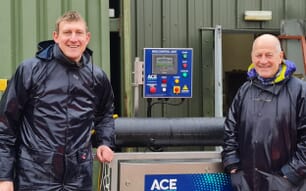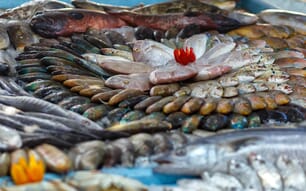Mighty Ships producers search for unique ships around the world and its seven year run has featured a wide range of vessels including cruise ships, aircraft carriers, cargo ships, dredgers and more. The programs focus heavily on operational capabilities and technical aspects of the ships and also make use of computer-generated animation to show underwater operations.
What attracted them to the 184-foot freezer/longliner Northern Leader is its joystick controlled, eco-friendly propulsion system that runs on electricity, the first U.S. fishing vessel to do so, and its head to tail use of the fish.
“That’s the sweet spot--fully using the fish,” said Keith Singleton, vice president of marketing for Alaskan Leader Seafoods, a company started by Kodiak fishermen in 1991, and which now owns four fishing vessels in partnership with the Bristol Bay Economic Development Corporation.
The three-year old Northern Leader fishes primarily for cod in the Bering Sea. As it was being designed, Singleton said the group traveled several times to Iceland to select processing equipment that would fully utilize each fish.
Every fish coming over the rail gets bled and run through a chilled tank that produces ‘amazing snow white’ fillets that fetch a much higher price, Singleton said. All of the fish heads go into a grinder for use in the pet food industry.
“The head is 25-27 percent of the entire animal, so that’s a big number. And if you can monetize that, it really helps the bottom line,” he added. “It pays the crew better, and it fills up the holds faster and makes for shorter fishing trips and that saves on fuel.”
“We also have a customer that takes 100 percent of the livers for cod liver oil, and a skin customer that takes all of the cod skins. Right now we’re trying to find markets for the other viscera,” he added.
Singleton said the Mighty Ships invitation is one of the company’s proudest moments, as it will be aired in 169 countries to over 40 million viewers.
“More than anything it’s really going to give the Alaska seafood industry some great press and that’s really what we want to impress upon the general public,” Singleton said. “It isn’t about us, it’s about all of us.”
A free premier showing of the F/V Northern Leader program, along with a catered cod fish dinner, is set for June 10 at the Afognak Center in Kodiak. Questions? Check Alaskan Leader Seafoods on Facebook.
Groundfish festival – Gaining some recognition of the importance of groundfish in Alaska’s seafood portfolio is the goal of trawl groups who are hosting a festival and parade on June 11 from 5-8 in downtown Kodiak.
The event, backed by the Alaska Whitefish Trawlers Association and the Groundfish Data Bank, features free seafood dishes, a pie toss and other games, prizes and raffles with all proceeds going to the Brother Francis Shelter.
“This is a positive means of promoting our industry and shedding some light on how important groundfish fisheries are to the economy of Kodiak,” said fisherman Paddy O’Donnell.
The event happens as the North Pacific Fishery Management Council convenes in Kodiak for a week-long meeting dominated by plans to carve up 25 different kinds of groundfish catches among trawlers. The new plan aims to reduce unwanted bycatch of halibut, salmon and other species taken by trawl nets in the Gulf of Alaska.
About 65 trawl vessels target pollock, cod and other groundfish throughout the Gulf; 40 of them are homeported at Kodiak. Groundfish made up 83 percent of all Kodiak landings in 2014 totaling 273 million pounds, an increase from 57 million pounds in 2009.
What fish, Where fish? Have you ever wondered where all that Alaska fish ends up around the world? Seafood is by far Alaska’s largest and most valuable export – nearly 2.5 billion pounds valued at $3.28 billion in 2014.
A new report titled Where Do Alaska Fish Go profiles the markets for groundfish and crab – which accounted for 80 percent of Alaska’s total seafood volume and 65 percent of the first wholesale value.
“It tells a story of Alaska fisheries products - where they are going, who the consumers are on the other end and what the competing species are –things that unless you’re really involved in the market, you might not know,” said Ben Fissel an economist at the Alaska Fisheries Science Center in Seattle. The AFSC collaborated with the Pacific States Marine Fisheries Commission and McDowell Group on the project.
“The idea was to produce a document that tells the story of what happens to the fish once it leaves the primary processors in Alaska. And we also wanted to put numbers behind it,” Fissel said.
Here are a few numbers through 2014 ---
- Alaska’s fisheries are the most productive in the nation, accounting for 60 percent of total U.S. harvests.
- Alaska fishermen produce 18 percent of the world’s cod harvest. Pacific Ocean Perch is Alaska’s most abundant rockfish species – there are 70 kinds of rockfish!
- Alaska produces 65 percent of the world’s sablefish (black cod) - 80 percent goes to Japan.
- About three-quarters of Alaska’s halibut goes out frozen to U.S. restaurants and grocery stores. Ditto, Alaska king and snow crab.
One of the biggest booms for Alaska groundfish has been oils, nearly all from pollock.
In 2014, nearly 28,500 tons of fish oil worth $32 million was produced primarily by Alaska shore side processors — a 271 percent increase in value from 2005.
Prices for Alaska crude grade fish oil rose from an average $436 per ton in 2004 to $1,130 a ton in 2014.




